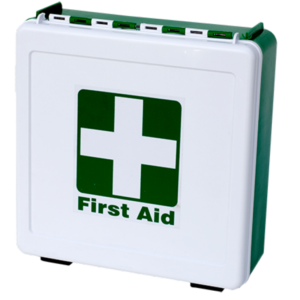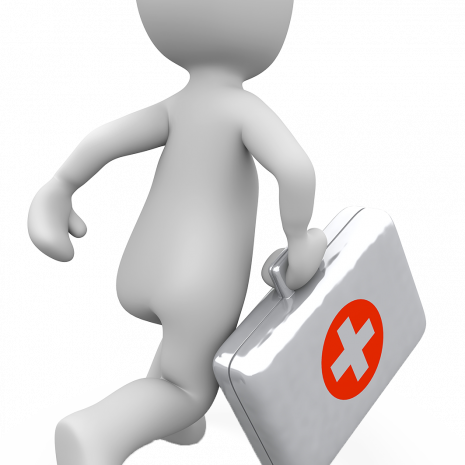Introdcution
What is First Aid?
First aid is administered to minimise the consequences of injury and illness until qualified medical assistance is available. It also includes the treatment of minor injuries, such as small cuts that would not normally require qualified medical assistance.
Legal duties
The regulations place duties on the employer and the self-employed to provide facilities that enable first aid to be given to employees if they are injured or become ill at work. In the majority of cases, trained and qualified first-aiders must administer first aid. The regulations also require employers to inform employees of first-aid arrangements.
- England, Scotland and Wales
- The Health and Safety (First-Aid) Regulations 1981
- Northern Ireland
- Health and Safety (First-Aid) Regulations (Northern Ireland) 1982
- Republic of Ireland
- Chapter 2 of Part 7 of the General Application Regulations 2007
Employers duties
- Employers are required to make provision for employees to receive first-aid treatment.
- Employers must ensure equipment and facilities provided are adequate and appropriate.
- Employers must provide an adequate and appropriate number of suitable persons to provide first aid to employees who are injured or become ill at work.
- A person must be appointed to take charge of first-aid facilities and equipment if the first aider is absent.
- Depending on the nature of the undertaking, number of employees at work and the location of the establishment, the employer may appoint a person to take charge of first aid, rather than providing a qualified first aider.
- A self-employed person must provide, or ensure there is provided, adequate and appropriate equipment to enable self-administered first aid while at work.
- Employers are required to inform employees of first-aid provisions, including the location of equipment, facilities and personnel.
First aiders
First aiders are people who have successfully attended an appropriate training course,. This is typically a First Aid at Work (FAW) or an Emergency First Aid at Work (EFAW) course, and someone who holds a current certificate.
Appointed person
An appointed person is someone with some first-aid knowledge who can look after the first-aid equipment (e.g. restocking the first-aid box) and take charge when someone is injured or falls ill, including calling an ambulance, if required, and passing on the relevant information.
The minimum requirement under the law is to provide an appointed person to take charge of first-aid arrangements. However, an appointed person is not a first aider at work under the terms of the legislation and should not attempt to give first aid for which they have not been trained.
Appointed persons can be used to provide emergency cover in the absence of first aiders, but only when the absence is due to exceptional, unforeseen and temporary circumstances. Absences such as annual leave do not count.
Assessment of first-aid needs
Employers are required to carry out an assessment of first-aid needs. This involves consideration of workplace hazards and risks, the size of the organisation and other relevant factors, to determine what first-aid equipment, facilities and personnel should be provided.
Required number of first aiders
The below table outlines the required number of first- aiders vs the number of employees and the business environment
| Category of hazard | No. of employees | Number of first aid personnel |
|---|---|---|
| Low hazard, eg. offices, shops, libraries | Fewer than 25 | At least one appointed person |
| 25 to 50 | At least one first aider trained in 'Emergency first aid at work' (EFAW) | |
| More than 50 | At least one first aider trained in 'Emergency first aid at work' (EFAW) for every 100 employed (or part thereof) | |
| High hazard, eg. light engineering and assembly work, food processing, warehousing, extensive work with machinery or sharp instruments, construction, chemical manufacture | Fewer than 5 | At least one appointed person |
| 5 to 50 | At least one first aider trained in 'Emergency first aid at work' (EFAW) | |
| 50 or more | At least one first aider trained in 'Emergency first aid at work' (EFAW) for every 50 employed (or part thereof) |
Self employed
If you are self employed you are required to ensure you have such equipment, as may be adequate and appropriate in the circumstances, to provide first aid to yourself while at work.
You should make an assessment of the hazards and risks in your workplace and establish an appropriate level of first-aid provision. If you carry out activities involving low hazards (eg clerical work) in your own home, you would not be expected to provide first-aid equipment beyond your normal domestic needs. If your work involves driving long distances or you are continuously on the road, the assessment may identify the need to keep a personal first-aid kit in your vehicle.
Many self-employed people work on mixed premises with other self-employed or employed workers. Although you are legally responsible for your own first-aid provision, it is sensible to make joint arrangements with the other occupiers and self-employed workers on the premises. This would generally mean that one employer would take responsibility for first aid for all workers on the premises. HSE strongly recommends there is a written agreement for any such arrangement.
First aid equipment
Regulations require first-aid equipment to be provided as required and state that it should be easily accessible. The minimum requirement is to provide a first-aid box, clearly marked and containing essential first-aid equipment. It is necessary to ensure that boxes are adequately stocked at all times and maintained in a condition fit for use. This requires a regular checking and restocking regime.

The contents off your first aid kit contents will be governed by findings of your risk assessment.
Thought should be given to what potential injuries could occur. Then making sure you have the relevant medical supplies to reduce further harm.
First aid room requirements
- A sink with running hot and cold water (which should always be available).
- Drinking water when not available on tap, and disposable cups.
- Soap (preferably liquid soap).
- Paper towels.
- Smooth-topped working surfaces.
- A suitable store for first-aid materials.
- A range of first-aid equipment, at least to the standard required in first-aid boxes.
- Suitable, foot-operated refuse container, lined with a disposable plastic bag.
- A couch (with a waterproof surface), and frequently cleaned pillow and blankets.
- A chair preferably wipe-able.
- An appropriate record-keeping book.
- A bowl.
- Clean, protective garments for use by first-aiders.
- A telephone or other suitable means of communication.
Duty of care of first aiders
First-aiders have the normal responsibilities as laid down by Health & Safety legislation – Additionally, they have a common law duty of care to the people they treat. However, providing the first aider has been appointed by the employer and gives first aid on behalf of that employer then it is likely that the employer will be held liable for the actions of the first-aider in the event of any civil claim. If the first-aider were to use their skills outside of the workplace, the duty of care may pass to the individual.
There has not been a civil suit against a first-aider for negligence.
Insurance
In most cases the employer’s compulsory liability insurance will cover the actions of a qualified first-aider or appointed person when undertaking first aid at work and following the techniques given at their training. If in doubt, the insurers or the insurance broker should be contacted to clarify the situation.

